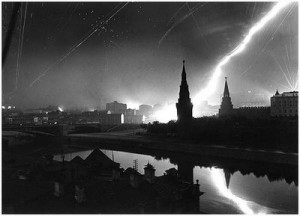Joseph Stalin: “Moscow will be defended to the last!” 70th Anniversary October 19, 1941
“Before three months have passed, we shall witness a collapse in Russia, the like of which has never been seen in history.”—Adolf Hitler, 2:30am, June 22, 1941
October 1941 was an especially grim time for the Soviet Union as it appeared that Adolf Hitler might win his historical gamble to crash in the Soviet Union and end the eastern war with a military victory before the United States was drawn into the conflict. A solitary Great Britain would then be forced to come to terms with Germany’s impregnable continental triumph. Hitler would then be free to pursue his dream of a greater Aryan empire in eastern Europe, an empire economically supported through enslaving the Slavic peoples while cleansing the lands of all racial undesirables. Hitler was betting that a Blitzkreig strike against the Soviet Union could attain a military defeat within six months, paving the way to his Aryan utopia.
The German army which launched Operation Barbarossa at 3:30am on June 22, 1941, along a long front stretching from the Baltic to the Ukraine totaled over 3.1 million men. In its mechanical force it had nineteen panzer divisions and twelve motorized divisions, 3,350 tanks, 5,000 aircraft, and 7,000 pieces of artillery. General von Bock’s Army Group Center, located in the center of the line, had two objectives: first to capture Minsk, and then make the decisive strike to the heart by driving to Moscow. Army Group North would capture the Baltic and Leningrad; Army Group South would drive to Kiev and the southern oil fields. Hitler’s Blitzkreig strategy again relied upon speed, and the initial thrust did not disappoint. His Panzer divisions knifed ahead fifty miles a day once the attack was launched; German forces were overrunning and encircling Soviet troops. Because the Soviet troops had been warned, their superior numbers did not translate into resistance, but rather greater numbers of captured prisoners. The Luftwaffe was initially very effective in cutting rail and road support for the Soviet armies, and over 5,000 Soviet planes were destroyed on the ground by August, almost fifty percent of the Soviet front-line defensive air strength.



